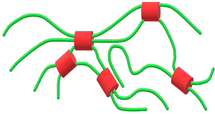Difference between SBR and SBC
Thermoplastics > Styrenics
SBR y SBC | ||
Styrenic Thermoplastic Elastomer (TPS, TPE-S), also known as Styrenic Block Copolymers (SBC) are usually defined as compounds based on SB, SBS, SIS, SEP, SEEPS and SEBS. They are copolymers of tri-blocks containing an elastomeric middle block and polystyrene end blocks. The middle rubber block is typically a polydiene (polybutadiene for SBS and SEBS or polyisoprene for SIS). Styrenic Elastomer (SBR), also known as Styrene Block Rubber (SBR) are elastomers that have to be vulcanized. Styrene butadiene rubber (SBR) have a better resistance to abrasion than natural rubber (NR), as well as better resistance to high temperatures (100 ° C) and aging, but lower flexibility and elasticity at low temperatures (up to around -50 ° C). It has moderate resilience, excellent abrasion resistance, moderate tear resistance, excellent impact resistance, moderate flexural strength. In the case of high temperatures, vulcanizates of SBR have a hardening and not a softening as with the vulcanizates of natural rubber. The gas permeability presented is high but lower than that of vulcanized natural rubber while the chemical resistance is similar to that of natural rubber. |  | |
| Difference between SBR and SBC | ||
Styrenic Thermoplastic Elastomer (TPS, TPE-S), also known as SB, SBS, SIS, SEP, SEEPS and SEBS are unsaturated tri-block copolymers, while SBC resin is a saturated di-block copolymer. All do not need vulcanization, while SBR rubber needs to be vulcanized to provide good physical and mechanical properties. |  | |
